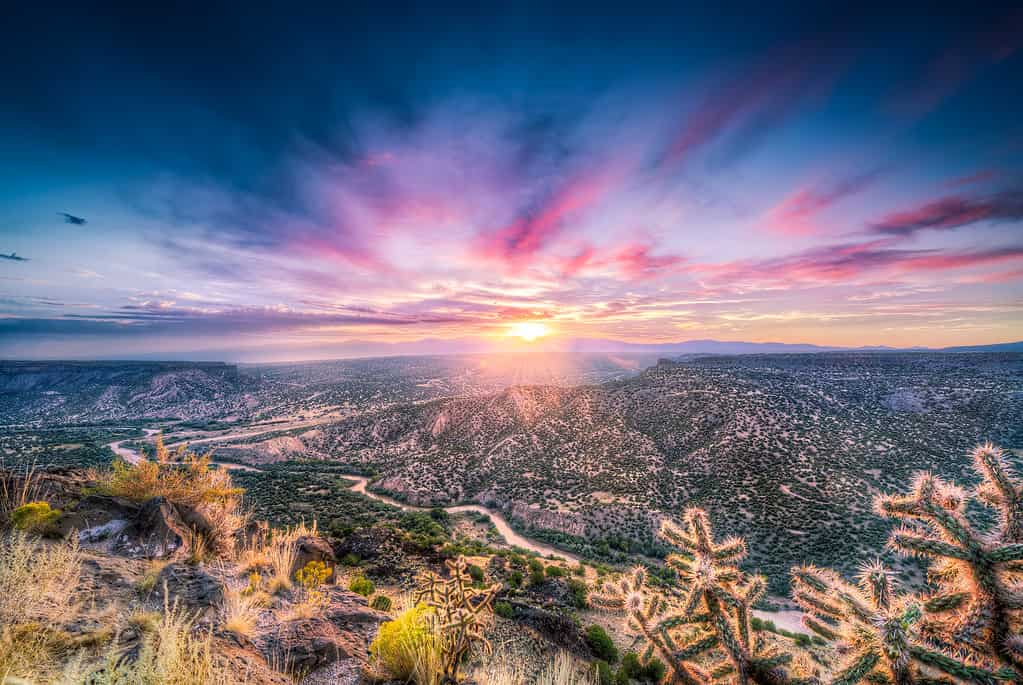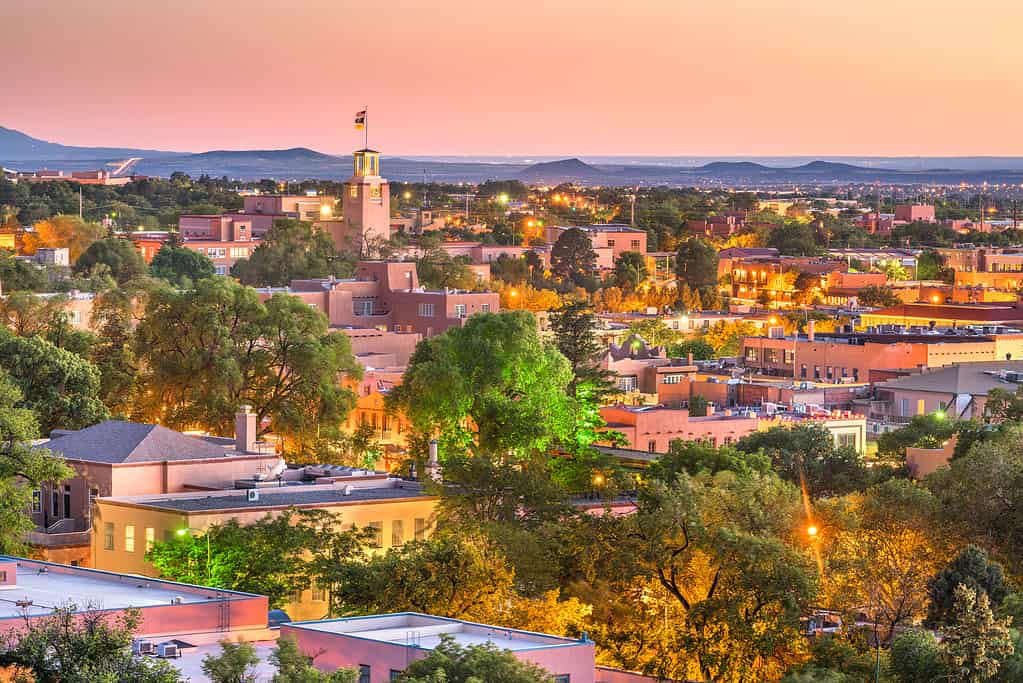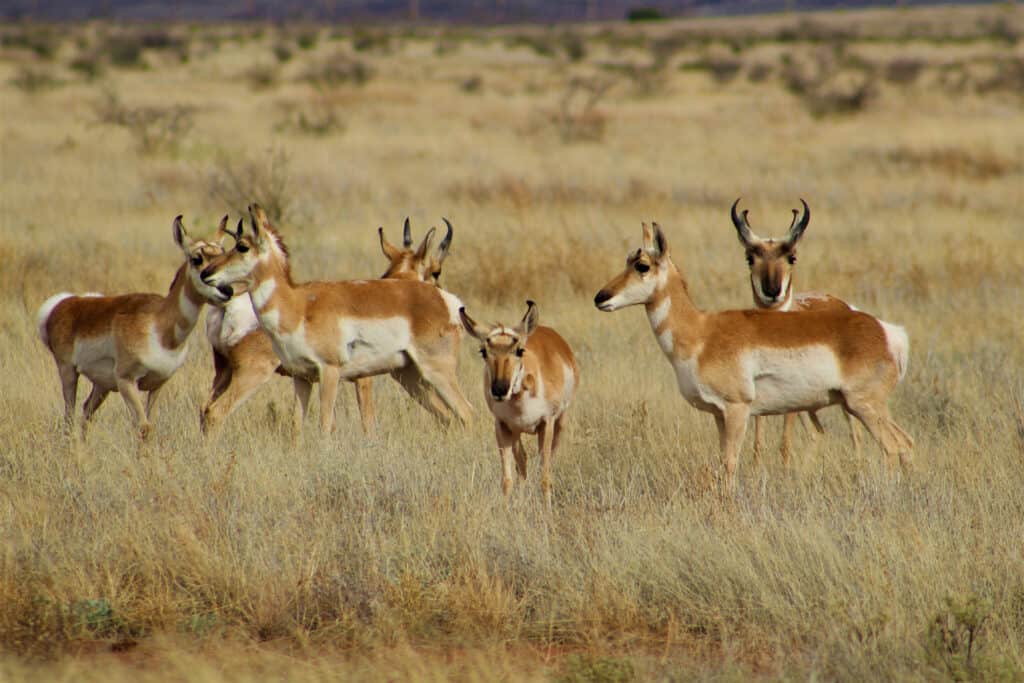New Mexico, also called the “Land of Enchantment,” is one of the largest states in the country. Rich in natural beauty, diverse landscapes, and cultural heritage, it is a hidden gem in the American West.
Only a U.S. state for over a century, New Mexico is primarily influenced by its proximity to Mexico, creating a unique blend with its large native population. The state has numerous Native American Pueblos, such as Acoma and Taos Pueblo. The mix of Hispanic and Native American cultures reflected in the state’s art, tradition, and cuisine is unlike any other in the United States.
New Mexico is roughly 344 miles (552 kilometers) wide from its easternmost to westernmost point.
Becoming Part of the United States

New Mexico was under Spanish rule over three times longer than it has been a U.S. state.
©rarrarorro/iStock via Getty Images
At first, modern New Mexico was part of the Spanish colonial empire in the Americas. Spanish explorers, missionaries, and settlers arrived in the late 16th century. Their presence lasted nearly three centuries, during which New Mexico remained under Spanish rule.
After Mexico gained independence from Spain in 1821, Mexico took control of New Mexico. It became part of the Mexican territory of Santa Fe de Nuevo México. During the period, which roughly lasted two decades, the region had a mix of Spanish, Native American, and mestizo (mixed-race) populations.
At first, New Mexico lived under Mexico’s rule with few tensions. But when the United States annexed its neighbor Texas in 1845, it led to tensions along the United States-Mexican border. These conflicts quickly escalated alongside various other events, leading to the Mexican-American War in 1846.
Acquisition by the United States
As part of Mexican territory, New Mexico became a large theater of operations during the war, especially along its border with Texas. In August 1846, General Stephen W. Kearny led U.S. troops into Santa Fa, New Mexico’s capital. As U.S. forces took control of the territory, it marked the beginning of its transition into the United States.
In 1848, the treaty of Guadalupe-Hidalgo ended the war, and Mexico gave up New Mexico and other territories to the United States. After the war, New Mexico became a U.S. territory, and its territorial government was established in 1850.
Five years later, in 1853, the U.S. continued its expansion southwest with the Gadsden Purchase. They bought this strip of land (present-day southwestern New Mexico and southern Arizona) to construct a transcontinental railroad route. This established New Mexico’s current southern border with Mexico.
The territory stayed under federal governance for over 60 years and gained statehood on January 6, 1912, becoming the U.S. 47th state.
Geography of New Mexico

New Mexico boasts very different landscapes throughout the state.
©Dean_Fikar/iStock via Getty Images
Even though New Mexico is often seen as a desertic state, the “Land of Enchantment” boasts a sharp contrast between its high desert plateaus, rugged mountains, and vast deserts.
New Mexico has varied and high elevations, contributing to diverse climate zones. These range from alpine tundras in the mountains to arid deserts in the southern parts of New Mexico. It highly contributes to New Mexico’s varied landscapes.
Desert Landscapes
The most significant portion of New Mexico is its arid and semi-arid desert landscapes. In the southern part of the state, the Chihuahuan Desert is a must-see. With stunning and undulating gypsum dunes, the White Sands National Park is the perfect spot for sandboarding and watching incredible night skies. Additionally, the Rio Grande Rift in Central New Mexico runs through the state, creating low-lying basins surrounded by mountain ranges.
Rocky Mountains
But New Mexico is not all deserts. It is also home to several mountain ranges, with the Sangre de Cristo Mountains to the north and the southern extension of the Rocky Mountains. In the Taos area, Wheeler Peak is just one example of how high New Mexico mountains can reach. It is ideal for hikes, wildlife watching and in the winter, skiing, snowboarding, and other winter adventures!
High Plateaus
The Colorado Plateau is a characteristic feature of the state’s northwestern region with its deep canyons, high plateaus, and mesas. It offers the stunning Chaco Culture National Historical Park, where visitors can explore the remains of ancient Puebloan civilization and learn about its history.
Great Plains
Crossing into the eastern part of New Mexico comes with a slow transition into the Great Plains with its fertile plains, grasslands, and prairies. The region is home to thriving agricultural activities, including crop cultivation and ranching.
Rio Grande River
The Rio Grande River, a famous waterway, flows through New Mexico, bisecting the state from north to south. This river serves as the lifeblood of the region and the state. It provides vital water for agriculture, recreation, and diverse ecosystems.
Volcanic Features
New Mexico’s volcanic past is not very well-known. However, the state boasts some unique volcanic features, such as the Malpais lava fields. Also, it is home to the Valles Caldera, one of the world’s largest calderas. Visiting the geological formations offers tourists great insight into the state’s volcanic past.
Caves and Caverns
Another prominent feature in New Mexico is its numerous caves and caverns, with the Carlsbad Caverns being one of the most famous. These underground geological formations boast stunning limestone landscapes.
Overall Size of New Mexico

Santa Fe is the highest state capital in the United States, with an elevation of 7,199 feet (2,194 meters).
©Sean Pavone/iStock via Getty Images
In the southwestern United States, New Mexico is famous for its desertic landscapes and cultural diversity. With approximately 121,590 square miles (314,915 square kilometers) in total area, New Mexico is one of the biggest states in the country, ranking fifth largest. The state’s dimensions extend approximately 344 miles (552 kilometers) from easternmost to westernmost points at its widest points. It also spans roughly 371 miles (597 kilometers) from north to south.
With its large area and dimensions, New Mexico represents approximately 6.1% of the United States’ landmass. New Mexico has diverse landscapes with high mountain peaks, desertic landscapes, grasslands, and prairies. But this diversity fully contributed to the state’s identity.
Despite its extensive size, New Mexico is very sparsely populated. As of the 2020 U.S. census, New Mexico had a population of 2,117,522 people, ranking 36th in the United States, one of the least populated states in the nation. Additionally, the state’s density is 17.2/sq mi, the 45th less dense in the country. Large, vibrant urban centers and vast, empty natural spaces characterize this low density.
New Mexico’s vastness played a role in its history and development, including its economic reliance on agriculture, energy production, and tourism.
Where Is New Mexico Located on the Map?
New Mexico is a vast state in the heart of the American Southwest.
It borders several other states in the southwestern part of the U.S. To the north, it borders Colorado; to the northwest, Utah; and to the west, Arizona. Its southern border is shared with Mexico, its eastern border with Texas, and northeastern with Oklahoma.
With its strategic location, New Mexico is often a getaway to explore the American West. Visitors can start or finish in New Mexico and explore its neighboring states and national parks. It is the perfect place to explore the Four Corners region! This is the unique place where Arizona, Colorado, New Mexico, and Utah intersect.
After being under Spanish and Mexican rule, New Mexico is heavily influenced by the Hispanic and Native American cultures. The state’s cuisine, architecture, and traditions reflect its rich heritage.
New Mexico’s Width in Comparison to Other States
Let’s compare New Mexico’s width from its easternmost point to westernmost point to some other states!
| State | East-to-West Width (Approximate) |
|---|---|
| Texas | 773 miles (1,244 kilometers) |
| Oklahoma | 468 miles (756 kilometers) |
| Colorado | 380 miles (612 kilometers) |
| Wyoming | 375 miles (604 kilometers) |
| California | 360 miles (579 kilometers) |
| Nevada | 322 miles (519 kilometers) |
| New Mexico | 344 miles (552 kilometers) |
| Arizona | 310 miles (500 kilometers) |
| Idaho | 305 miles (491 kilometers) |
| Utah | 270 miles (434 kilometers) |
Wildlife in New Mexico

Pronghorns are the fastest land animals in North America and can attain a maximum speed of 60 mp/h (96 km/h).
©Charles Lemar Brown/Shutterstock.com
With its various range of landscapes and climate, New Mexico supports diverse ecosystems. These provide a wide range of habitats for different wildlife species.
New Mexico is committed to habitat protection and species conservation. Along with organizations, it holds initiatives, rehabilitation, reintroduction programs, and education opportunities. For example, New Mexico is part of a significant effort to reintroduce the Mexican Grey Wolves, a critically endangered species. This ensures the preservation of its rich biodiversity, flora, and fauna for many generations.
Mammals
- Black Bears: A healthy population of black bears lives in the state’s wooded and mountainous areas. Locals and visitors can often observe this adaptable species while looking for food.
- Bighorn Sheep: In the mountainous terrain of New Mexico live some populations of bighorn sheep. This species — with its impressive horns — is used to live in the mountains and its sometimes harsh climate.
- Bobcats: Bobcats are widespread in New Mexico and can live in deserts, forests, and mountains. These elusive predactors are recognizable thanks to their distinctive tufted ears.
- Coyotes: Coyotes are prevalent in New Mexico. They live in very remote areas to urban centers as a very adaptable species. At night, it is sometimes possible to hear them howl.
- Mexican Gray Wolves: New Mexico is an essential part of the recovery range for the critically endangered Mexican gray wolf. Conservation efforts are ongoing to reintroduce this species and protect its environment.
- Mountain Lions: This species is one or maybe even the apex predator (for mammals) in New Mexico. Living in the mountainous and forested regions, these elusive hunters are skilled hunters and play a crucial role in the ecosystem.
- Mule Deer: Mule deer are widespread in New Mexico, specifically in the mountainous regions and forests. They are distinct from other deer species thanks to their large ears.
- Prairie Dogs: These rodents live in eastern New Mexico in the open grasslands but also in the southern deserts. Prairie dogs play a significant role in the ecosystem by creating burrows that provide homes for other species.
- Pronghorn: Finally, pronghorn, also called American antelope, inhabit the state’s grasslands and open spaces. Pronghorns are famous for their incredible speed and rank as the fastest land animals in North America.
Birds
- Bald Eagles: These majestic birds commonly live near the Rio Grande River or bodies of water. They specifically thrive during the winter during migration as New Mexico offers warmer temperatures, plenty of food, and suitable nesting conditions.
- Golden Eagles: Alongside the bald eagles, New Mexico’s diverse landscapes are also home to the stunning golden eagle. These large raptors live in mountainous regions and can be seen flying above bodies of water, hunting for food.
Reptiles
- Desert Tortoises: In the deserts of southwestern New Mexico live desert tortoises, a species adapted to the arid environment.
- Gila Monsters: Distinctive for its orange and black coloration, the Gila monster inhabits the southwestern part of New Mexico. It is one of only two venomous lizard species in North America.
The photo featured at the top of this post is © MonaMakela/iStock via Getty Images
Thank you for reading! Have some feedback for us? Contact the AZ Animals editorial team.






